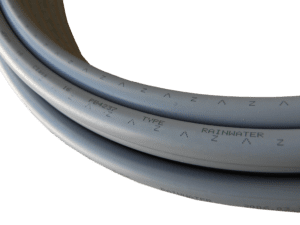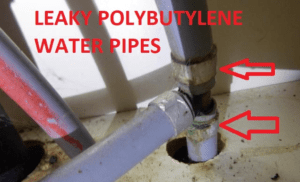Polybutylene Plumbing: What You Need to Know
Polybutylene pipes are a type of plastic pipe that was commonly used in homes from the late 1970s to the mid-1990s. These pipes were popular due to their low cost and ease of installation.
Why are Polybutylene Pipes a Problem?
Polybutylene pipes have a high failure rate and are prone to leaking, cracking, and breaking. This is due to the material’s poor resistance to chlorine and other chemicals commonly found in water. Over time, exposure to these chemicals can cause the pipes to become brittle and develop weak spots.
Spotting Polybutylene Pipes

Polybutylene pipes are usually gray in color, but can also be blue or black. They have a distinctive shape, with a thin, cylindrical body and a slightly larger fitting at each end. The pipes are typically stamped with the letters “PB” and a date code.
The Downside of Polybutylene Pipes
Leaks and Cracks

One of the most common problems with polybutylene pipes is leaks and cracks. These can occur due to the material’s poor resistance to chemicals and exposure to heat, which can cause the pipes to become brittle.
Pipe Breaks
Polybutylene pipes are also prone to breaking, which can be caused by a number of factors, including freezing temperatures, shifting soil, and physical damage.
Fitting Failures
Polybutylene pipes are connected to fittings using a crimping tool. Over time, these fittings and poly pipes can become brittle and crack, leading to leaks and other problems.
Repairing Polybutylene Pipes
DIY Repairs vs. Professional Repairs
While some homeowners may be tempted to attempt DIY repairs on their polybutylene pipes, it’s important to note that these pipes require specialized tools and expertise to repair properly. It’s often best to leave repairs to a professional plumber who has experience working with polybutylene pipes.
Polybutylene Pipe Replacement vs. Pipe Repair
In some cases, it may be necessary to replace the entire polybutylene pipe system in a home. However, in many cases, repairs can be made to individual sections of the pipe.
Methods of Polybutylene Pipe Repair
Full Pipe Replacement
If the polybutylene pipe system in a home is too damaged to be repaired, a full pipe replacement may be necessary. This involves removing all of the old pipes and fittings and replacing them with a new system.
In-Place Pipe Repair
In many cases, it’s possible to repair individual sections of the polybutylene pipe system without having to replace the entire system. This is known as in-place pipe repair.
Explanation of in-place pipe repair
In-place pipe repair involves repairing a section of the existing copper or polybutylene pipe system without having to remove the entire system. This is done by inserting a new pipe liner or coating the interior of the existing pipes with epoxy.
Common in-place pipe repair techniques
Pipelining
Pipe lining involves inserting a flexible tube or tubing into the existing polybutylene pipes and inflating it to create a new, smooth interior surface. This can help to prevent leaks and improve water flow.
Epoxy pipe coating
Epoxy pipe coating involves applying a thin layer of epoxy to the interior of the existing polybutylene pipes. This helps to seal any cracks or leaks and improves water flow.
Pipe bursting
Pipe bursting involves breaking apart the existing polybutylene pipes and pulling a new pipe through the resulting opening. This can be a more cost-effective alternative to full pipe replacement.
How to Repair a Polybutylene Pipe
Repairing a polybutylene pipe typically involves cutting out the damaged section of the pipe and replacing it with a new section. This requires specialized tools and expertise, so it’s best to hire a professional plumber to perform the repair.
The Benefits of Polybutylene Pipe Repair
Increased Longevity of Pipes
By repairing or replacing damaged polybutylene pipes, homeowners can extend the lifespan of their plumbing system and avoid costly repairs in the future.
Improved Water Quality and Flow Rate

Polybutylene pipes that are in good condition can provide clean, reliable water to a home. Repairing or replacing damaged pipes can help to improve water quality and flow rate.
Potential Increase in Home Value
Upgrading the plumbing system in a home, including repairing or replacing polybutylene pipes, can increase the home’s value and make it more attractive to potential buyers.
Preventing Future Polybutylene Pipe Problems
Regular Maintenance and Inspections
Regular maintenance and inspections can help homeowners to identify and address potential issues with their polybutylene pipes before they become major problems. This includes checking for leaks, cracks, and other signs of damage.
Upgrading to a New Plumbing System
In some cases, it may be necessary to upgrade to a new plumbing system to avoid future problems with polybutylene pipes. This can involve replacing the entire polybutylene piping system with new, more durable pipes and fittings.
How to Prevent Frozen Pipes
Frozen pipes can be a major problem for polybutylene pipes, particularly in mobile homes in colder climates. To prevent frozen pipes, homeowners can insulate their pipes, keep their home’s temperature above freezing, and take steps to prevent drafts and air leaks.
Hiring the Right Professional Plumber for the Job

Qualities to Look for in a Polybutylene Pipe Repair Specialist
When hiring a plumber to repair or replace polybutylene pipes, homeowners should look for a professional with experience working with these types of polybutylene pipes installed before.. They should also look for someone who is licensed, insured, and able to provide references.
Questions to Ask Before Hiring a Plumber
First and foremost, it is crucial to ensure that the plumber you choose is experienced and qualified to handle the job. To do this, ask for references and check their online reviews to get a sense of their track record.
How to Get the Best Price for Polybutylene Pipe Repair
When it comes to pricing, it is always wise to get multiple quotes from different plumbers. This way, you can compare their pricing and services to make an informed decision. Additionally, don’t be afraid to ask about any available discounts or promotions that may help you save even more on the repair or replacement of your polybutylene pipes.
FAQ
What is the lifespan of polybutylene pipes?
Polybutylene pipes are a ticking time bomb! They may have a short lifespan, and their high failure rate makes them a risky investment. Don’t wait for a disaster to happen before you act. Consider replacing your polybutylene pipes today.
Can you repair polybutylene pipes without replacing them?
Although the leak in some sections of the pipes can be repaired, in many cases, a complete replacement is necessary. This can be costly, but the price of delaying can be much higher.
What are the risks of using polybutylene pipes in a home?
These pipes have a high failure rate and are vulnerable to leaks, cracks, and other types of damage. Extreme weather conditions can also cause them to burst, leading to costly repairs and damage to your house or property.
How much does it cost to replace polybutylene pipes in a home?
While the price can vary based on several factors, including the size of your home, the extent of the damage, and the cost of labor and materials, you can expect to pay between $1,500 and $15,000 on average. According to HomeAdvisor, the average cost to replace polybutylene pipes in a home range from $2,000 to $7,000,
You may also like How Much Does It Cost to Repipe a House?
Will My Homeowners Insurance Cover Polybutylene Pipe Leaks?
Homeowners’ insurance policies may cover some or all of the cost of repairing or replacing polybutylene pipes that have experienced leaks or other types of water damage.
However, coverage can vary depending on the policy and the specific circumstances of the damage. Homeowners should check with their insurance provider to determine their coverage.
Is There a Class Action Lawsuit for Defective Polybutylene Plumbing?
There have been several class action lawsuits related to defective polybutylene plumbing, including a settlement agreement in 1995. However, these lawsuits are no longer active and homeowners should consult with a legal professional to determine their options.
Conclusion
Polybutylene pipes can be a major problem for homeowners, but there are steps that can be taken to repair or replace these pipes and prevent future issues. By working with a qualified plumber and staying on top of maintenance and inspections, homeowners can ensure that their plumbing system is reliable and long-lasting. Additionally, upgrading to a new plumbing system or taking steps to prevent frozen pipes can further improve the overall health of a home’s own plumbing systems.

